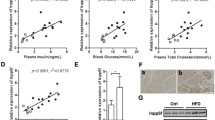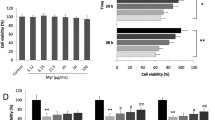Summary
Type 1 diabetes mellitus (T1DM) is associated with an increased risk of diabetic cardiomyopathy (DCM). Nuclear factor kappa B (NF-κB) and Wnt/β-catenin/GSK3β have been demonstrated to play pathogenic roles in diabetes. In this study, we evaluated the roles of these two pathways in T1DM-induced cardiomyopathy in rats. Streptozotocin (STZ)-induced type 1 diabetic rats were treated with pyrrolidine dithiocarbamate (PDTC) or meisoindigo (Me) to inhibit NF-κB and Wnt/β-catenm/GSK3β respectively for 4 or 8 weeks. As compared with untreated diabetic rats, treatment with either PDTC or Me partly attenuated the myocardial hypertrophy and interstitial fibrosis, improved cardiac function, and exhibited reduction in inflammatory reaction. In addition, we found that inhibiting NF-κB and Wnt/β-catenin/GSK3β pathways could regulate glucose and lipid metabolism. The effects were associated with the decrease of NF-κB activity and the downregulation of some proinflammatory cytokines, including tumor necrosis factor-alpha (TNF-α) and interleukin (IL)-2. Our data suggested that the activities of NF-κB and Wnt/β-catenin/GSK3β pathways were both increased and inhibiting NF-κB and Wnt/β-catenin/GSK3β signaling pathways might improve myocardial injury in T1DM rats.
Similar content being viewed by others
References
Zhang Z, Zhang D, Dou M, et al. Dendrobium officinale Kimura et Migo attenuates diabetic cardiomyopathy through inhibiting oxidative stress, inflammation and fibrosis in streptozotocin-induced mice. Biomed Pharmacother, 2016,84:1350–1358
Liu Q, Wang S, Cai L. Diabetic cardiomyopathy and its mechanisms: Role of oxidative stress and damage. J Diabetes Invest, 2015,5(6):623–634
van Diepen JA, Thiem K, Stienstra R, et al. Diabetes propels the risk for cardiovascular disease: sweet monocytes becoming aggressive. Cell Mol Life Sci, 2016,73(24):4675
Wan A, Rodrigues B. Endothelial cell-cardiomyocyte crosstalk in diabetic cardiomyopathy. Cardiovasc Res, 2016,111:172–183
Rajesh M, Mukhopadhyay P, Bátkai S, et al. Cannabidiol attenuates cardiac dysfunction, oxidative stress, fibrosis, inflammatory and cell death signaling pathways in diabetic cardiomyopathy. J Am Coll Cardiol, 2010,56(25):2115–2125
Guo R, Nair S. Role of microRNA in diabetic cardiomyopathy: From mechanism to intervention. Biochim Biophys Acta, 2017,1863:2070–2077
Zheng X, Zhu S, Chang S, et al. Protective effects of chronic resveratrol treatment on vascular inflammatory injury in streptozotocin-induced type 2 diabetic rats: Role of NF-kappa B signaling. Eur J Pharmacol, 2013,720(1–3):147–157
Mong M, Yin M. Nuclear Factor κB-Dependent Anti-inflammatory Effects of s-Allyl Cysteine and s-Propyl Cysteine in Kidney of Diabetic Mice. J Agric Food Chem, 2012,60(12):3158–3165
El-Sahar AE, Safar MM, Zaki HF, et al. Neuroprotective effects of pioglitazone against transient cerebral ischemic reperfusion injury in diabetic rats: Modulation of antioxidant, anti-inflammatory, and anti-apoptotic biomarkers. Pharmacol Rep, 2015,67(5):901–906
Elçioğlu HK, Kabasakal L, Özkan N, et al. A study comparing the effects of rosiglitazone and/or insulin treatments on streptozotocin induced diabetic (type I diabetes) rat aorta and cavernous tissues. Eur J Pharmacol, 2011,660(2–3):476–484
Goudy KS, Johnson MC, Garland A, et al. Inducible adeno-associated virus-mediated IL-2 gene therapy prevents autoimmune diabetes. J Immunol, 2011,186(6):3779–3786
Dawson K, Aflaki M, Nattel S. Role of the Wnt-Frizzled system in cardiac pathophysiology: a rapidly developing, poorly understood area with enormous potential. J Physiol, 2013,591(6):1409–1432
Chong ZZ, Maiese K. Targeting WNT. Protein kinase B, and mitochondrial membrane integrity to foster cellular survival in the nervous system. Histol Histopathol, 2004,19(2):495–504
Hie M, Iitsuka N, Otsuka T, et al. Insulin-dependent diabetes mellitus decreases osteoblastogenesis associated with the inhibition of Wnt signaling through increased expression of Sost and Dkk1 and inhibition of Akt activation. Int J Mol Med, 2011,28(3):455–462
Eren G, Cukurova Z, Hergunsel O, et al. Protective effect of the nuclear factor kappa B inhibitor pyrrolidine dithiocarbamate in lung injury in rats with streptozotocin-induced diabetes. Respiration, 2010,79(5):402–410
Huang M, Ho PC. Identification of metabolites of meisoindigo in rat, pig and human liver microsomes by UFLC-MS/MS. Biochem Pharmacol, 2009,77(8):1418–1428
Zhu YF, Ye BG, Shen JZ, et al. Inhibitory effect of VPA on multiple myeloma U266 cell proliferation and regulation of histone acetylation. Zhongguo Shi Yan Xue Ye Xue Za Zhi (Chinese), 2010,18(3):638–641
Sheng R, Gu ZL, Xie ML. Epigallocatechin gallate, the major component of polyphenols in green tea, inhibits telomere attrition mediated cardiomyocyte apoptosis in cardiac hypertrophy. Int J Cardiol, 2013,162(3):199–209
Wei H, Qu H, Wang H, et al. 1,25-Dihydroxyvitamin-D3 prevents the development of diabetic cardiomyopathy in type 1 diabetic rats by enhancing autophagy via inhibiting the β-catenin/TCF4/GSK-3β/mTOR pathway. J Steroid Biochem Mol Biol, 2017,168:71–90
Tsai SJ, Huang CS, Mong MC, et al. Anti-inflammatory and antifibrotic effects of naringenin in diabetic mice. J Agric Food Chem, 2012,60(1):514–521
Martinez A, Castro A, Dorronsoro I, et al. Glycogen synthase kinase 3 (GSK-3) inhibitors as new promising drugs for diabetes, neurodegeneration, cancer, and inflammation. Med Res Rev, 2002,22(4):373–384
Monika, Sharma A, Suthar SK, et al. Synthesis of lantadene analogs with marked in vitro inhibition of lung adenocarcinoma and TNF-α induced nuclear factor-kappa B (NF-κB) activation. Bioorg Med Chem Lett, 2014,24(16):3814–3818
Kameyama N, Arisawa S, Ueyama J, et al. Increase in P-glycoprotein accompanied by activation of protein kinase Cα and NF-κB p65 in the livers of rats with streptozotocin-induced diabetes. Biochim Biophys Acta, 2008,1782(5):355–360
Ohsaki Y, Shirakawa H, Miura A, et al. Vitamin K suppresses the lipopolysaccharide-induced expression of inflammatory cytokines in cultured macrophage-like cells via the inhibition of the activation of nuclear factor κB through the repression of IKKα/β phosphorylation. J Nutr Biochem, 2010,21(11):1120–1126
Zelarayan L, Gehrke C, Bergmann MW. Role of beta-catenin in adult cardiac remodeling. Cell Cycle, 2007,6(17):2120–2126
Garciamartín A, Reyesgarcia R, Garcíafontana B, et al. Relationship of Dickkopf1 (DKK1) with cardiovascular disease and bone metabolism in Caucasian type 2 diabetes mellitus. PLoS One, 2014,9(11):e111703
Yung-Chien H, Chang PJ, Cheng H, et al. Protective effects of miR-29a on diabetic glomerular dysfunction by modulation of DKK1/Wnt/β-catenin signaling. Sci Rep, 2016,6:30575
Semënov MV, Zhang X, He X. DKK1 Antagonizes Wnt Signaling without Promotion of LRP6 Internalization and Degradation. J Biol Chem, 2008,283(31):21 427–21 432
Hu Y, Gu X, Li R, et al. Glycogen synthase kinase-3β inhibition induces nuclear factor-κB-mediated apoptosis in pediatric acute lymphocyte leukemia cells. J Exp Clin Cancer Res, 2010,29(1):1–8
Hoeflich KP, Luo J, Rubie EA, et al. Requirement for glycogen synthase kinase-3beta in cell survival and NF-kappaB activation. Nature, 2000,406(6791):86–90
Author information
Authors and Affiliations
Corresponding author
Additional information
Conflict of Interest Statement
No conflict of interest exits in the submission of this manuscript, and manuscript is approved by all authors for publication.
This project was supported by the Research Award Fund for Outstanding Young Scientists Plan in Shandong Province of China (No. BS2013SW008), and the Innovation Project of Shandong Academy of Medical Sciences.
Rights and permissions
About this article
Cite this article
Liu, Jj., Shentu, Lm., Ma, N. et al. Inhibition of NF-κB and Wnt/β-catenin/GSK3β Signaling Pathways Ameliorates Cardiomyocyte Hypertrophy and Fibrosis in Streptozotocin (STZ)-induced Type 1 Diabetic Rats. CURR MED SCI 40, 35–47 (2020). https://doi.org/10.1007/s11596-020-2144-x
Received:
Revised:
Published:
Issue Date:
DOI: https://doi.org/10.1007/s11596-020-2144-x




